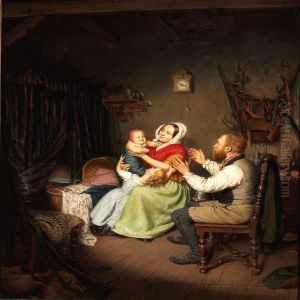Theodor Francken Paintings
Theodor Francken, also known as Theodoor Francken II, was born in 1581 in Antwerp, a city then bustling with cultural and artistic activity as part of the Spanish Netherlands. He hailed from a renowned family of artists, the Francken dynasty, which played a significant role in the development of Flemish painting during the late 16th and early 17th centuries. His father, Frans Francken the Elder, and his brothers, including Frans Francken the Younger and Hieronymus Francken II, were all established painters, each contributing to the family's legacy in their unique ways. This environment undoubtedly influenced Theodor and provided him with the foundational skills and inspiration crucial for his development as an artist.
Theodor Francken's career is less documented than those of his more famous relatives, but he still made his mark in the art world of his time. He was known for his genre scenes, history paintings, and allegorical works, employing a style that blended the elaborate detail characteristic of Flemish painting with an emerging Baroque sensibility. His works often depicted religious themes, mythological scenes, and everyday life, showing a range of subjects similar to those favored by his brothers. Despite the shadow cast by his more famous family members, Theodor's paintings were appreciated for their quality and complexity, contributing to the rich tapestry of Flemish art.
Francken was active primarily in Antwerp, where he became a master in the city's Guild of Saint Luke in 1605. This guild was a key institution for artists of the time, providing a network that facilitated commissions, apprenticeships, and collaborations. Through the guild, Theodor would have engaged with the vibrant artistic community in Antwerp, sharing ideas and influences with his contemporaries and the next generation of painters.
Theodor Francken's death in 1649 marked the end of an era for the Francken family's direct involvement in the Flemish art scene. While not as widely recognized today as some of his contemporaries or even family members, his contributions to the Flemish Baroque period are undeniable. His works are preserved in various collections and museums, offering insight into the transitional period of Flemish art and the broad talent that existed within the Francken family lineage. Through his paintings, Theodor Francken continues to represent the interconnectedness of family, artistry, and the cultural vibrancy of 17th-century Antwerp.
